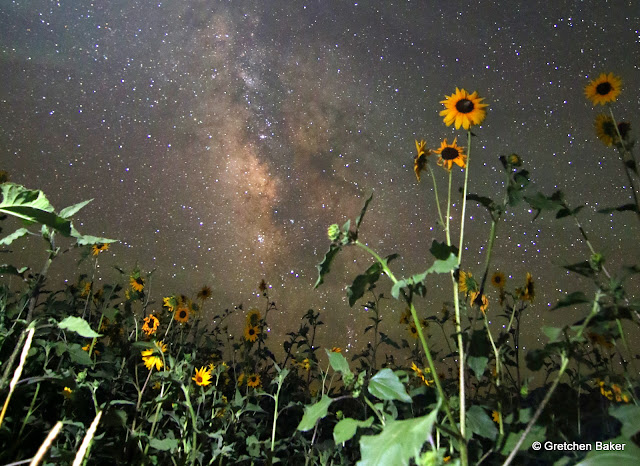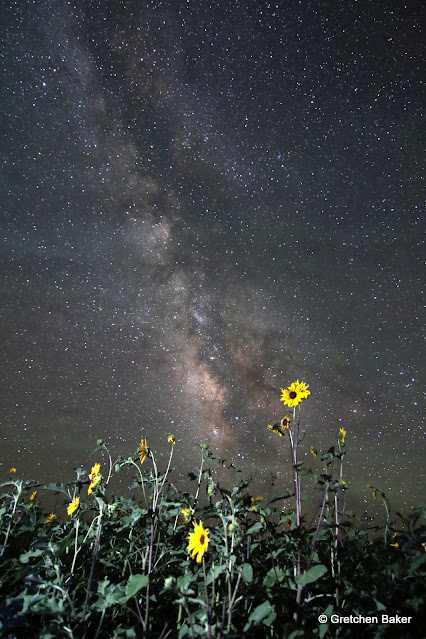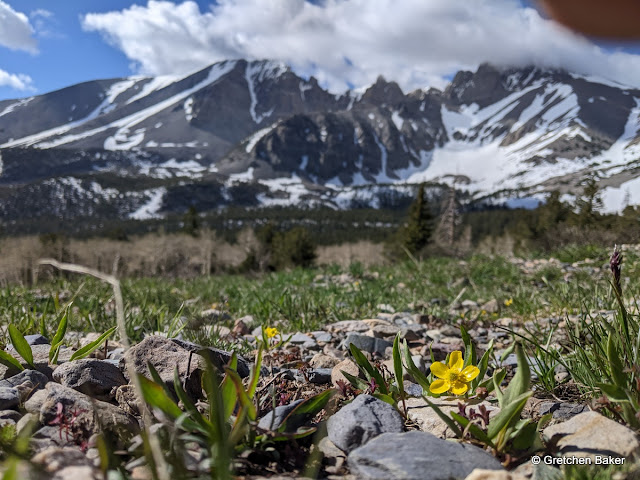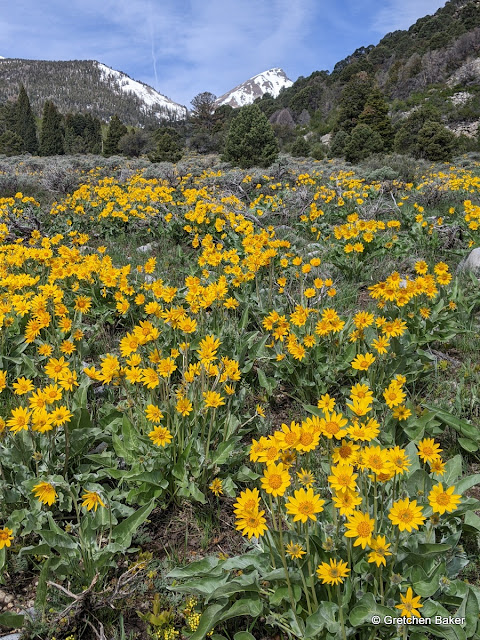Near mid-June 2023, the Wheeler Peak Scenic Drive opened. Most years it opens before Memorial Day weekend (last weekend in May), but this year there was so much snow it opened later. Desert Boy and I decided to go for a hike on the Alpine Lakes trail. Even at the trailhead, there was so much snow!
We didn't think to wear microspikes/exospikes/Yaktrax. Desert Boy fell down several times. I had a hiking pole and that helped me stay up.
When we got out of the trees more, we found patches where the snow had melted. But overall, we estimated that about 80% of the trail was covered with snow!
The orange blazes on the trees helped us know where the trail was.
Close to the lake we arrived at the sign showing the trail up to Wheeler Peak. That definitely was not in the plans for us that day! We could see plenty of snow ahead just on the way to Stella Lake.
To my surprise, as we approached the lake, I saw a lot of open water.
The lake wasn't entirely snow and ice free, though. We went to the corner with the most ice and snapped a selfie.
Desert Boy wasn't interested in a swim for some reason.
Some of the snow had a pinkish tinge to it, an indication that watermelon algae was present. As the saying goes, "Don't eat the pink snow!" Okay, maybe it's a different color that the saying refers to. But it's still not a good idea to eat the pink snow, it may cause some digestive troubles.
I was just slightly enamored with the lake and had to take one more photo from this vantage point.
As we walked around the lake, I spotted the viewing bench in the water. Desert Boy gamely jumped up on it for this humorous shot.
Desert Boy was wearing some new boots and was getting a blister. He found a tiny patch of ground and applied a bandaid.
The trail between Stella and Teresa Lakes was hard to follow, and we got lost for a bit.
But then we found our way, and soon were seeing Teresa Lake!
The lake was really full.
I was intrigued by the ice layer near the lake's edge.
Desert Boy was trying to kick off an "iceberg" and managed to plunge his foot into the lake.
He posed on another water-logged bench.
As we left the lake, we found some deep snow. We met another hiker coming back from the Bristlecone Trail, who had turned around despite having microspikes because he felt it was too dangerous.
This twisted tree is along the trail back to the parking lot, and looks extra cool surrounded by snow.
I was delighted when Desert Boy decided he liked hiking and wanted to go on another hike, up Bald Mountain. We started from the Summit trailhead. We did not find many flowers, despite it being the second part of June. A few snow buttercups lent a pop of color to the landscape. At this point, the clouds were just grazing the tops of the mountains.
This might be a golden mantled ground squirrel. It was not very afraid of us.
As we headed up Bald Mountain, we encountered lots of sun cups, or patterns in the snow that had melted out in roughly the shape of cups.
In quite a few of them, we found this bug, which we've seen other times on the hike up to Wheeler Peak.
To my surprise, we also saw a bunch of grasshoppers.
It was a windy day, and as we climbed higher, the wind got stronger. The clouds got lower. We decided it was time to turn around.
It was a lovely morning in beautiful scenery.
The aspen were just starting to leaf out. You can see which way the wind blows.
The top of the mountain is missing!
It's fun seeing everything with more snow on it than usual.
At the time of this posting, mid-July, there is still a fair bit of snow above 10,000 feet. It's interesting to see how different things look this year, including plants flowering much later, and stream and lake levels higher than usual.













































































